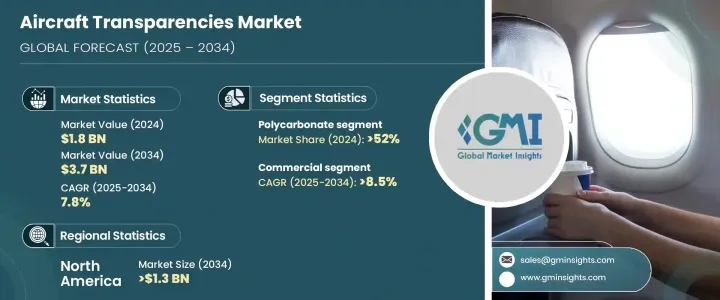
세계의 항공기용 투명필름 시장은 2024년에 18억 달러로 평가되었고 2025년부터 2034년에 걸쳐 CAGR 7.8%를 나타내 현저한 성장을 이룰 것으로 예측되고 있습니다.
이 성장 궤도는 연비 효율을 높이고 이산화탄소 배출량을 줄이는데 기여하는 경량의 내구성 소재에 대한 항공 산업의 급박한 수요에 힘입어지고 있습니다.

항공업계에서는 지속가능성과 운항효율을 중시하는 경향이 강해지고 있으며, 이러한 목표를 지원하는 첨단소재에 대한 요구가 항공기용 투명필름 시장의 기술 혁신을 뒷받침하고 있습니다. 친환경적 이니셔티브의 추진은 항공기의 경량화뿐만 아니라 우수한 내구성과 안전성을 제공하는 투명재의 채용을 항공사에 촉구하고 있습니다. 게다가 세계 항공 여객 수 증가가 새로운 항공기 모델의 도입으로 이어지고 있으며, 성능과 여객의 쾌적성을 모두 향상시키는 소재에 대한 수요가 더욱 높아지고 있습니다.
| 시장 범위 | |
|---|---|
| 시작 연도 | 2024년 |
| 예측 연도 | 2025-2034년 |
| 시작 금액 | 18억 달러 |
| 예측 금액 | 37억 달러 |
| CAGR | 7.8% |
항공기용 투명필름 시장은 주로 재료의 유형에 따라 구분되며, 유리, 아크릴, 폴리카보네이트가 가장 일반적인 선택입니다. 그 중에서도 폴리카보네이트가 최대 시장 점유율을 차지하고 2024년에는 시장의 52%를 차지했습니다. 이 소재의 인기가 높아지고 있는 것은 그 경량성에 관련되어 있어 항공사의 연료 소비량과 배출량의 삭감에 직접 도움이 되고 있습니다. 게다가 특수 코팅의 적용 등 폴리카보네이트의 기술 혁신에 의해 내구성이 향상되어, 항공기 제조업체나 운항 회사에 있어서도 매력적인 선택지가 되고 있습니다. 이러한 코팅은 마모나 손상으로부터 보호할 뿐만 아니라 자외선이나 얼음 부착 등의 환경 요인으로부터도 보호하고 소재의 수명을 연장하고 가혹한 조건 하에서도 그 효과를 유지합니다.
최종 용도의 관점에서 항공기용 투명필름 시장은 민간 부문과 군 및 방위 부문으로 나눌 수 있습니다. 민간항공분야는 2034년까지 연평균 복합 성장률(CAGR) 8.5%를 나타내 견조한 성장이 전망되고 있습니다. 항공사는 강도와 경량화를 모두 실현하고 비용 절감과 환경 보전을 가능하게 하는 투명 소재에 대한 관심을 높여가고 있습니다. 이러한 첨단 소재는 여객 경험을 향상시키기 위해 새로운 항공기의 설계에 통합되어 더 크고 견고한 창문이 표준화되고 있습니다. 항공사는 현재 흠집, 흐림, 시야 장애와 같은 일반적인 문제를 최소화하는 고급 코팅을 도입하는 데 주력하고 있으며 승객에게 편안하고 즐거운 하늘 여행을 제공합니다.
북미의 항공기용 투명필름 시장은 2034년까지 13억 달러를 창출할 것으로 예측됩니다. 미국에서는 연료 효율을 높이고 지속가능성 목표를 달성하기 위해 항공기의 경량화에 주력하고 있습니다. 이러한 경량 소재에의 주력에 의해 폴리카보네이트나 복합 소재에의 의존도가 높아지고 있습니다. 또한 군용기와 무인항공기(UAV)에는 고성능 투명필름이 필수적이기 때문에 군 및 방위 분야가 시장 성장에 크게 기여하고 있습니다. 항공우주 기술에 대한 투자가 증가함에 따라 이러한 시장 개척이이 지역 시장 확대를 뒷받침하고 있습니다.
The Global Aircraft Transparencies Market, valued at USD 1.8 billion in 2024, is projected to witness significant growth with a CAGR of 7.8% from 2025 to 2034. This growth trajectory is fueled by the aviation industry's pressing demand for lightweight and durable materials that enhance fuel efficiency and contribute to reducing carbon emissions.

As the aviation sector increasingly emphasizes sustainability and operational efficiency, the need for advanced materials that can support these goals is driving innovations within the aircraft transparencies market. The push for eco-friendly practices has encouraged airlines to adopt transparent materials that not only reduce the weight of aircraft but also provide superior durability and safety. Furthermore, the rising number of air passengers globally is leading to the introduction of new aircraft models, further boosting demand for materials that improve both performance and passenger comfort.
| Market Scope | |
|---|---|
| Start Year | 2024 |
| Forecast Year | 2025-2034 |
| Start Value | $1.8 Billion |
| Forecast Value | $3.7 Billion |
| CAGR | 7.8% |
The aircraft transparencies market is segmented primarily by material type, with glass, acrylic, and polycarbonate being the most common choices. Among these, polycarbonate holds the largest market share, representing 52% of the market in 2024. This material's growing popularity is linked to its lightweight nature, which directly helps airlines reduce fuel consumption and emissions. Additionally, innovations in polycarbonate, such as the application of specialized coatings, are enhancing its durability, making it a more attractive option for aircraft manufacturers and operators alike. These coatings not only protect against wear and tear but also guard against UV radiation, ice buildup, and other environmental factors, extending the life of the material and maintaining its effectiveness in extreme conditions.
In terms of end-use applications, the aircraft transparencies market is divided into commercial and military & defense sectors. The commercial aviation segment is expected to grow at a robust CAGR of 8.5% through 2034. Airlines are increasingly turning to transparent materials that provide both strength and weight reduction, enabling cost savings and environmental benefits. These advanced materials are integrated into new aircraft designs to enhance the passenger experience, with larger, more robust windows becoming standard. Airlines are now focusing on incorporating advanced coatings that minimize common issues like scratches, fogging, and visibility impairment, offering a more comfortable and enjoyable journey for passengers.
North America market for aircraft transparencies is projected to generate USD 1.3 billion by 2034. In the U.S., manufacturers are focused on reducing aircraft weight to boost fuel efficiency and achieve sustainability targets. This focus on lighter materials has led to an increased reliance on polycarbonate and composite materials. Additionally, the military and defense sectors are contributing significantly to market growth, as high-performance transparencies are essential for military aircraft and unmanned aerial vehicles (UAVs). These developments, alongside increased investment in aerospace technologies, are propelling market expansion in the region.